Leaving the Rio Dulce
The problem with a relatively deep draft, 2.05 metres in our case, is that you have to coincide leaving the river with the highest tide you can get. For us this was at 6:30pm local time on the 29th Jan, when a 0.5m tide was predicted. But more on that shortly...
Clear of the hazards
Our destination was Cayo Quemado, also known locally as Texan Bay or Gringo Bay, about 6nm from the river entrance at Livingston. Texan Bay is a well known and often used anchorage for yachts leaving, or having just come in the river. For anyone interested, it can be found at 15 degrees’46.11N by 088 degrees’49.75W. We anchored in the outer part of the bay as we were unsure of the depth to go further in. As it happened it was an ideal spot, as it was right opposite Cayo Quemado Sails and Rigging. The owner Tom was on hand to take our old genoa in for repair and storage until we return in June. We might as well put the wear and tear on the old sail when crossing the Pacific next year, rather than our relatively new one. The potentially baggy shape will not be harmful to our downwind performance.
We once again met with Gerry and Isolde on Northern Sky, as Gerry was having Tom reinstall his furling staysail. Gerry and Isolde are calling time on cruising in Northern Sky, and the yacht is up for sale. They can bow out in style though, having sailed around the world on her.
Northern Sky
We called in to Mini Mikes Juke Joint for a spot of lunch. Sadly Mike was not around, his barbecues are the stuff of legends, but we had a very tasty lunch all the same.
Mini Mikes' Juke Joint
We booked a launcha to take us from Texan Bay to Livingston to complete our clearing out formalities with our agent, Raul. Of course it was pouring with rain, so instead of marveling at the stunning scenery, we pulled our hoods tight over our heads to avoid the stinging rain. We opted to do this so we could simply turn up on Aztec Dream later that afternoon and leave, rather than anchor off and have to take the rib to the dock.
We had already missed our previous target date earlier in the month to leave on a slightly higher tide, due to the overrun on the new deck, but this was about as good as it would get until the next best high tide in June, which is the one we hope to return in on.
We had booked both a tow and a tilt. With light fading and a swell running with a drizzle, it was far from the ideal conditions we had entered in on last May. Our tow boat hooked us up, and we went a long way out before the other boat came back from tilting over another cruiser. By this time we were already being dragged through the silt. Once the spinnaker halyard was passed to the other boat, we were leaned over with the toerails underwater for what seemed like an age before we finally cleared the bar. We attached a waterproof bag containing the payment for the tow and tilt services, $60 per boat, using a strong rubber band to the tow boat line and set a course some 10nm North to Cabo Tres Puntas, an anchorage used by many coming to and from the river. We set the course and pressed Auto on the autopilot. After a few minutes the pilot disengaged and we noticed one of the course digits on the three digit display had failed to appear. It was clear we had a problem, but nothing we could do about it other than hand steer to the anchorage and diagnose the issue at a later time.
Broken Autopilot Head Unit
For three nights at anchor, the boat bucked like a bronco. A large cold front was upon us, and with it came strong winds and unrelenting rain. It was a miserable time on board and sleep was at a premium.
Passage to Utila
Once the front passed we were treated to blue skies and calm seas, but the weather would be closing in again in a few days. We left the anchorage and sailed in ideal conditions on a North Easterly course to our first destination of the season, the Honduran Bay Island of Utila, rather than going directly East.
This was on the best advice we had in order to give ourselves some distance off the coast of mainland Honduras, due to potential pirate attacks. The autopilot still refused to work, so we had to hand steer all the way to our destination. During the night, we decided to do 2 hour watches as it is tiring hand steering. As the sun set, the wind dropped to virtually nothing, so we put the engine on. About half an hour later a wonderful blood red moon appeared with its reflection mirrored in the calm sea.
The passage was uneventful. Steve called up a merchant ship in the night, as the closest point of approach in a half hour window was down to feet. The watch office acknowledged he could see us on radar, and would be making a course correction to pass about 1nm behind us.
Utila
It was dawn when we sighted Utila. The island is very low lying, with just one prominent hill. We motored around to the only anchorage, giving the outlying reefs a wide berth. We had been given waypoints to the entrance and into the anchorage, as some questioned the accuracy of the electronic navigation charts, and we are pleased to report all went smoothly.
The red square denotes roughly where we anchored
Once rested, we took the rib ashore to start the clearing in process. This ended up taking most of the next morning as we had to submit a photograph of the stern of the boat showing the name and home port, and also be fingerprinted and have our photos taken. Once all was approved, we took down the yellow Q flag and hoisted the courtesy flag on the starboard spreader.
From the anchorage we cold just about glimpse through the cloud, Mainland Honduras, about 20 miles away.
Utila is a small island, just 11km by 4km at its widest point, and the population is roughly 4,000. The main industry apart from tourism, is diving. It is one of the cheapest places in the Caribbean to learn to dive, and also has many attractions for the experienced diver too. Utila is also on the path of migrating whale sharks. The largest recorded length of a whale shark was 12.65 metres, and they are fortunately vegetarian for those wishing to take a closer look. They do have teeth, some 3000 of them, but they are soft and unlikely to bite you.
Wall art
Our first priority, having found our backup autopilot head unit was not working either, was to source at least one replacement. The unit is a Raymarine ST6002 and no longer made. However, we found an unused one for sale on eBay in the UK. We contacted Phill (Lynne’s brother) who has sourced a fair few items for us from eBay over the years, and sure enough later that week he secured that unit. In the meantime, Lynne had popped a request for one on the Rio Dulce and Bay Islands of Honduras Facebook pages, and a fellow cruiser in Belize had seen it and responded. Our friends Dov and Rebecca kindly agreed to pick it up and meet us in Roatan the next month, so all worked out well in the end.
Island Tour
We met a lovely couple also in the anchorage, on the yacht Abundance. David and Yvonne hail from the USA and stopped at Utila to wait out the strong Easterly winds, before continuing on to Panama to transit the canal then on to New Zealand. We hatched a plan to rent a golf buggy together and do our own island tour. You can’t rent a car on Utila, so it is either a motorbike or a buggy. One of our aims was to climb Pumpkin Hill, the only real hill on the island.
Pumpkin Hill to the right of picture
We called into a place called the Jade Seahorse to visit the eclectic garden, which we are told is still a work in progress.The owners are Neil and Julia Keller who have spent over 20 years creating the gardens, which now includes a gourmet restaurant and cabin for overnight guests.
The coastal area is rugged, with a mixture of volcanic rock and dead corals.
L to R Lynne, David and Yvonne
We made it to the base of Pumpkin Hill and walked up the very overgrown path, but the view was worth it. After that, we continued up and found the lighthouse. Unfortunately the view from the lighthouse was obscured by the dense undergrowth.
Our path!
After a leisurely climb of Pumpkin Hill, we headed back into town for a bite to eat. Whilst at the restaurant, one of the divers brought out a dead Lionfish. The Lionfish is a beautiful looking fish, but is an invasive species and has poisonous spines and skin however, the flesh is tasty, or so we are told. They are a terrible problem in the Western Atlantic, Caribbean Sea and the Gulf of Mexico, although they are not a problem in their native ranges of the Indian Ocean, Southern and Western Pacific and in the Red Sea. The Lionfish eats just about anything - fish, molluscs, shrimp, crab, juvenile octopus, squid, juvenile lobster, sea horses etc. and is responsible for decimating some fish populations. They can eat prey half the size of their own body, as long as it will fit into their mouths. Their stomach can expand to 30 times the normal volume, and the Lionfish will fill up to capacity as soon as it is able. They are also prolific breeders. The females can release egg masses every 4 days, up to 2 million per year. Lionfish are sexually mature at about 1 year of age and can live for more than 15 years. In many parts of the Caribbean it is actively hunted by divers to keep numbers under control.
The beaches around East Harbour has a number of lodges, hotels and beach bars, and is very nice.
Many thanks to David for driving the buggy, and getting it and us back in one piece.
Altogether, we spent about 3 weeks in Utila. It is a delightful little island, but it was time to move on. We had one more lunch of Baleadas, the local speciality, very tasty and well worth trying if you get the chance.
Lobster Baleada
We had waited for the prevailing Easterly winds to subside before heading East to the next and much larger island of Roatan. We managed to motorsail for the first few hours, but the wind died and the sails went away. Just before we reached Roatan, we noticed a black shape in the water. With much excitement we managed to take a few pictures of what turned out to be Sperm Whales, a mother and her calf. They came very close to the boat, an amazing experience.
Whales
We look forward to exploring Roatan and fingers crossed, the replacement autopliot will fix the issue.







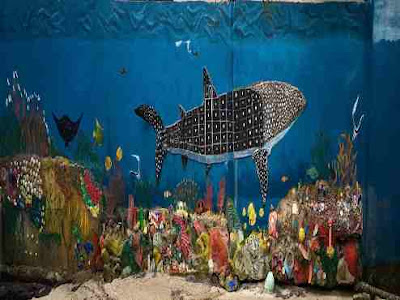
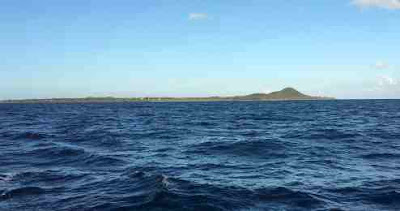

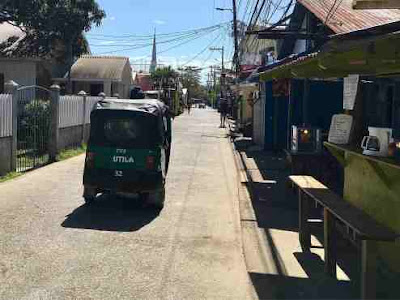
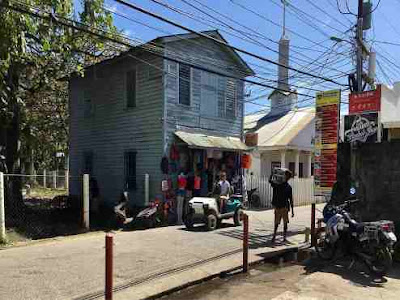








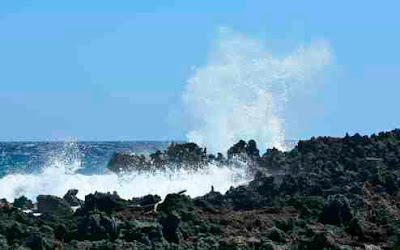


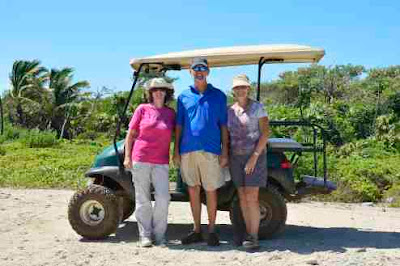

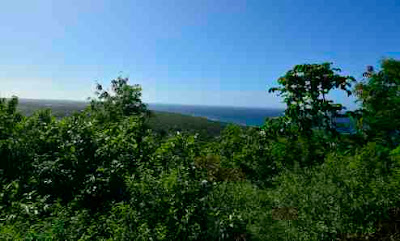


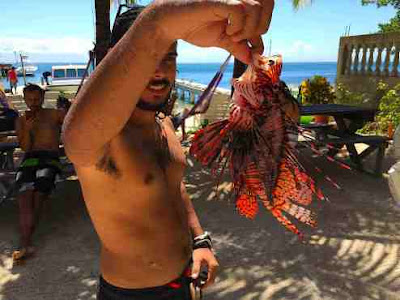
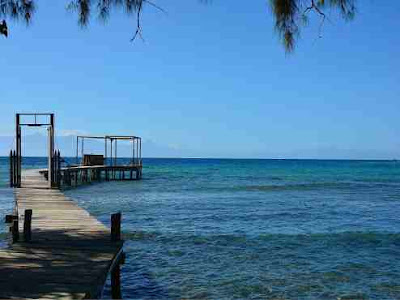


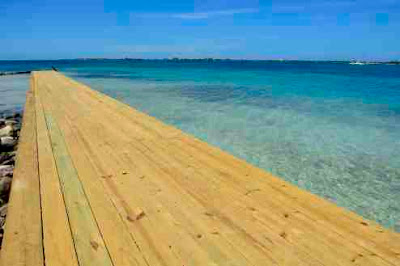

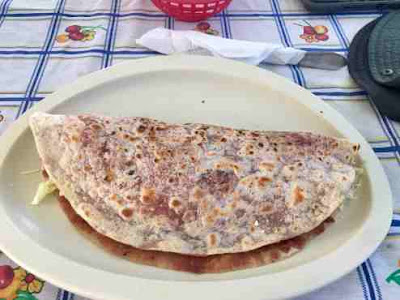


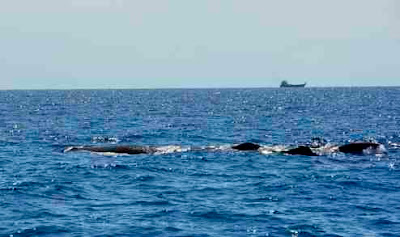
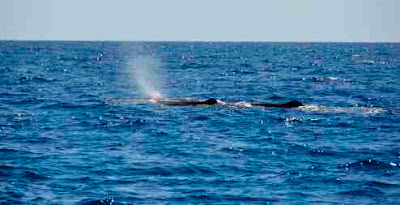
No comments:
Post a Comment